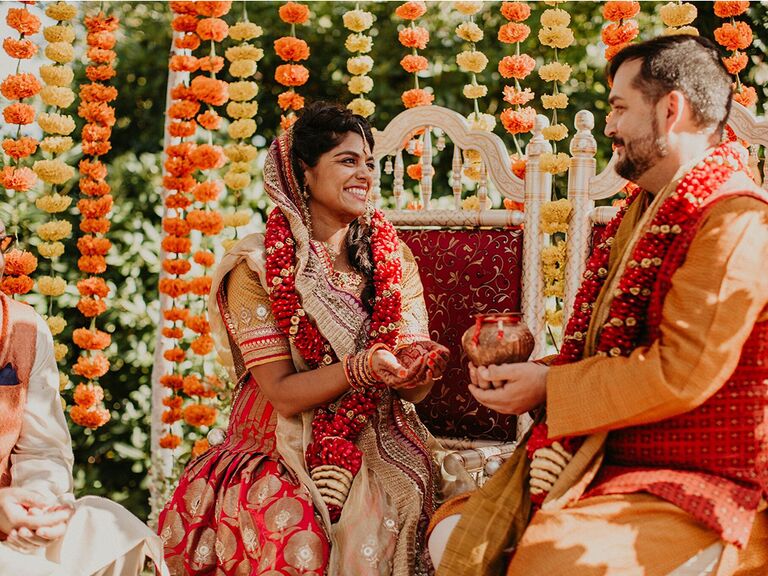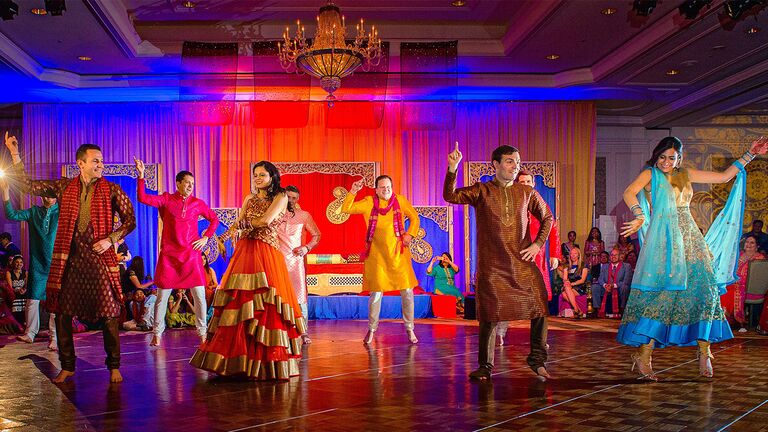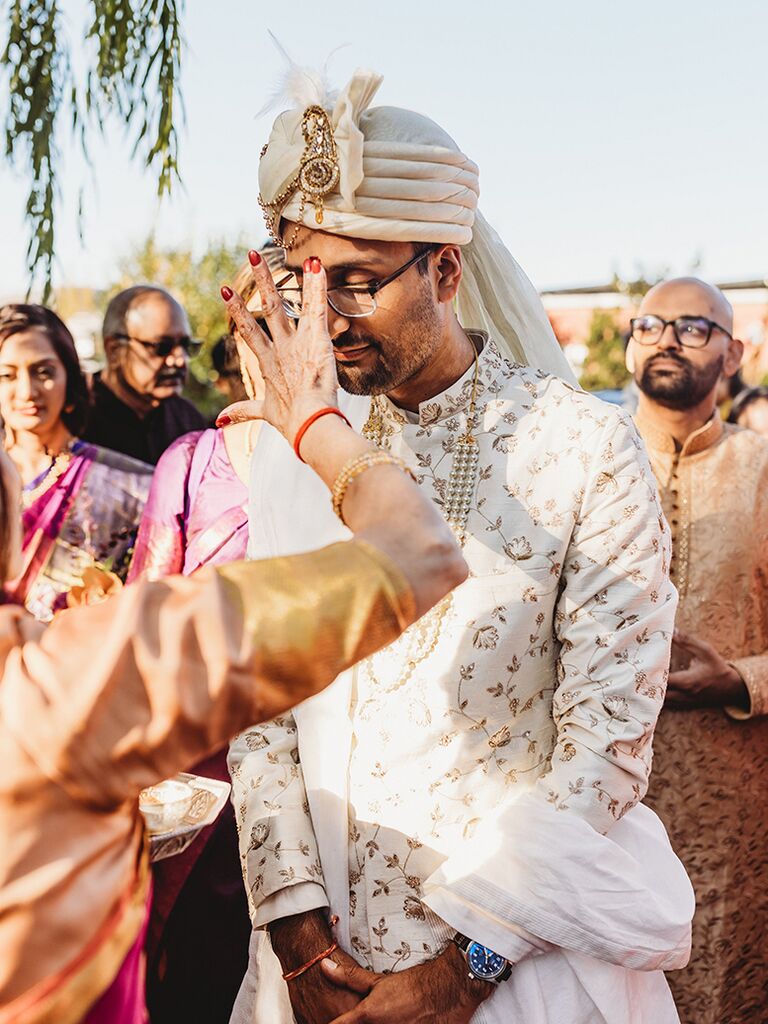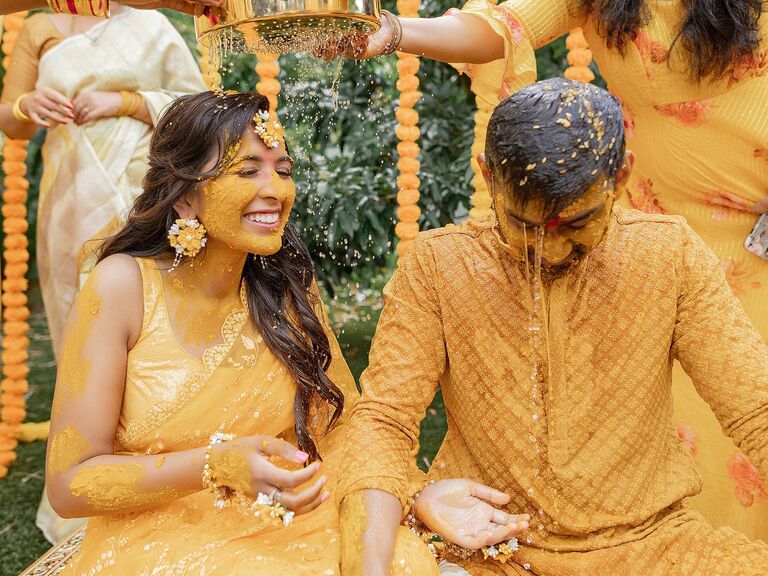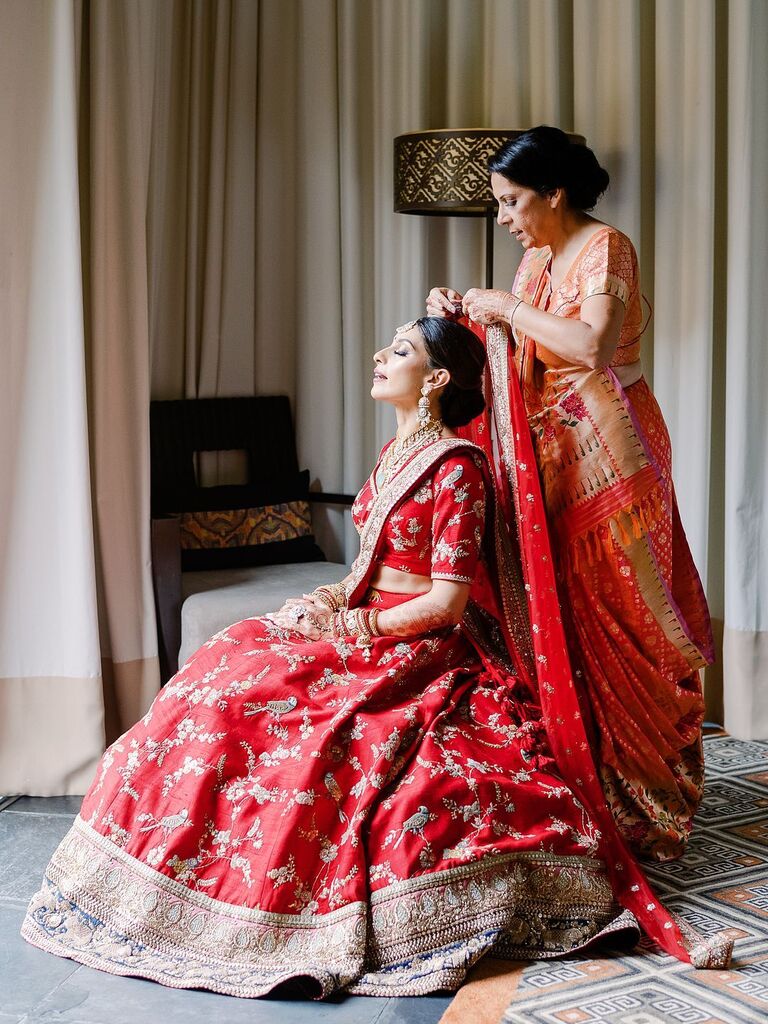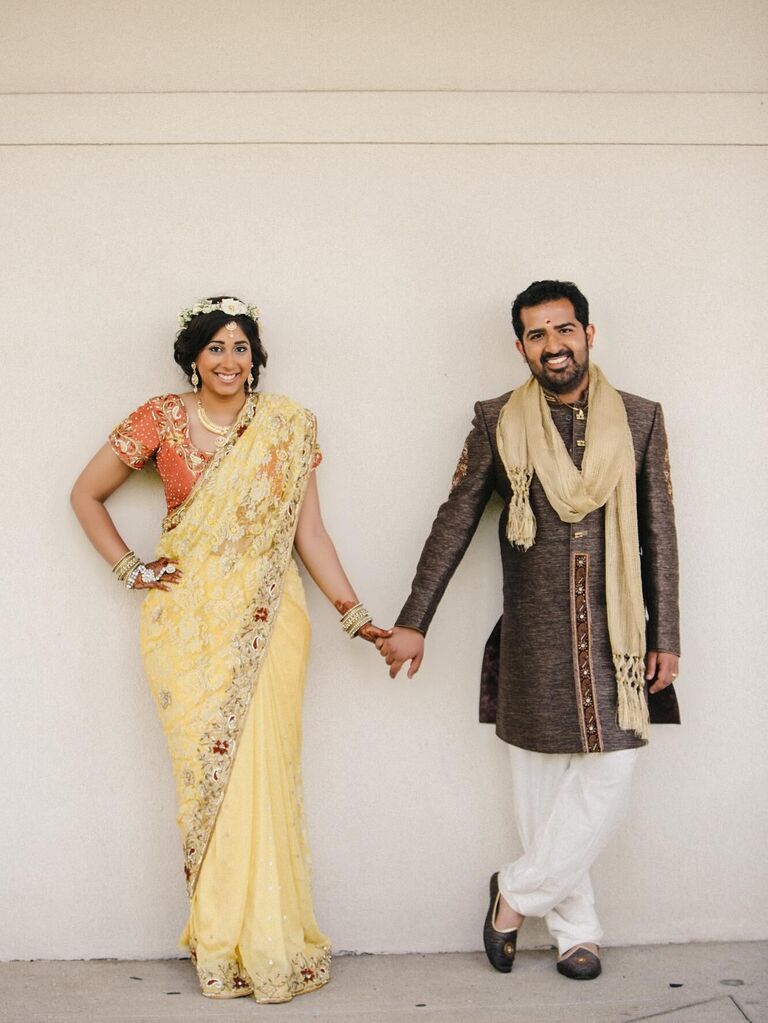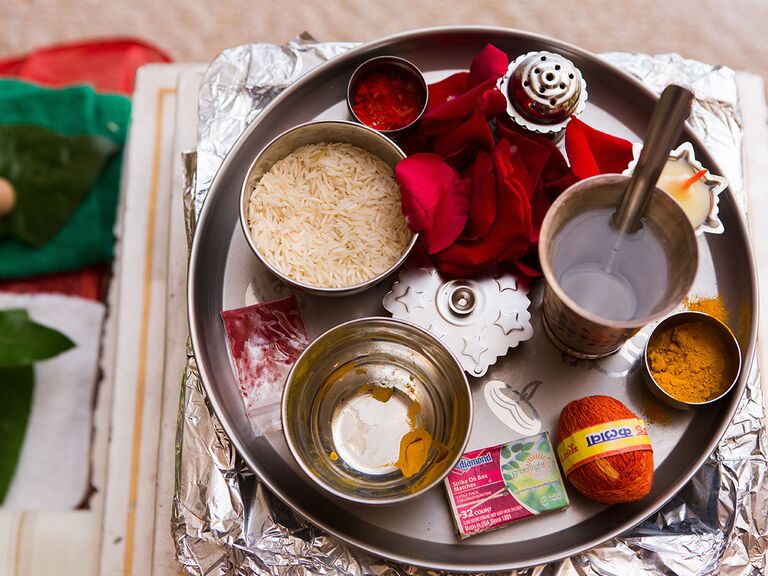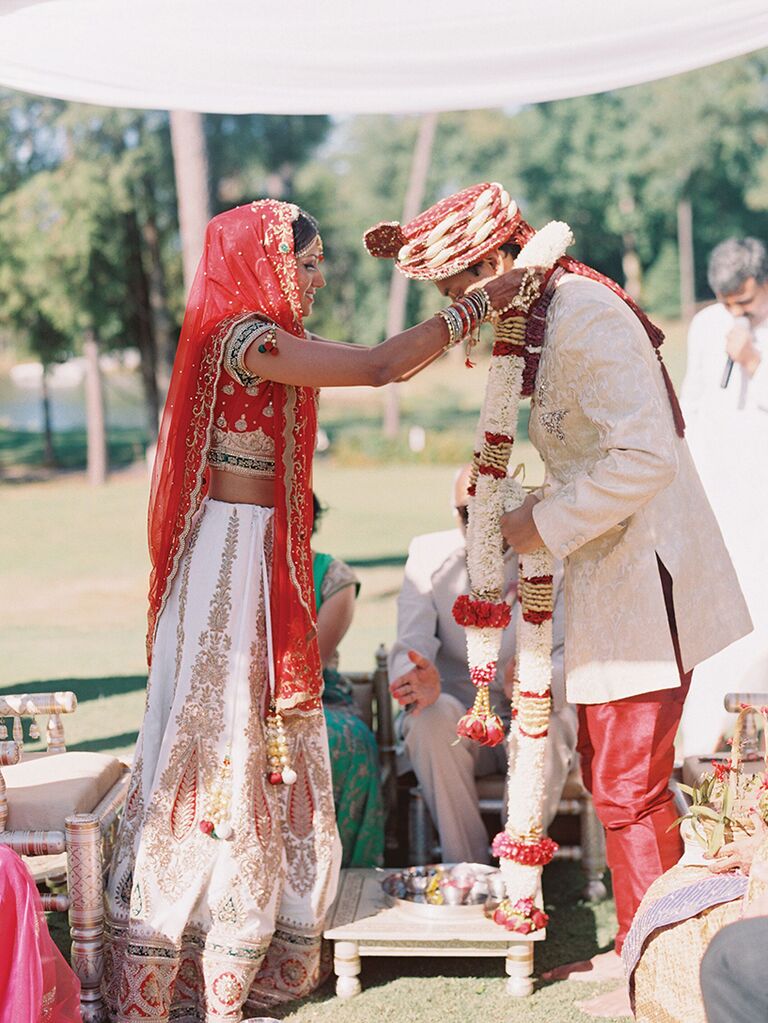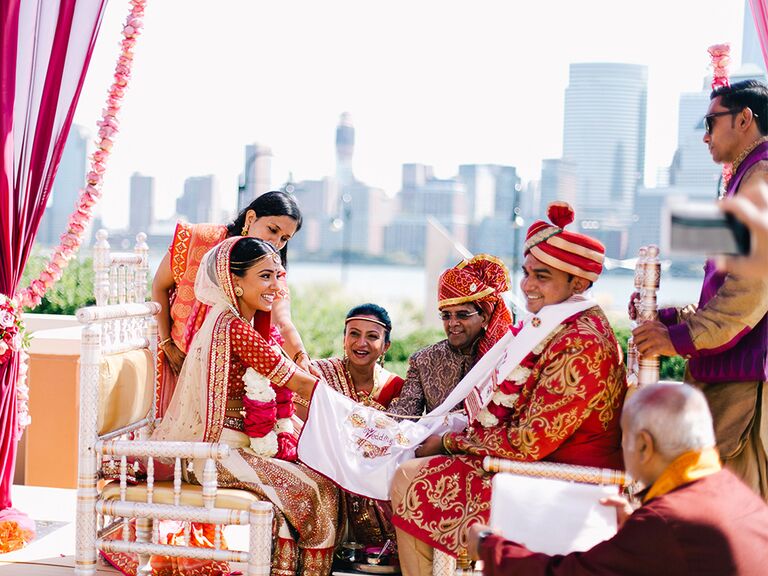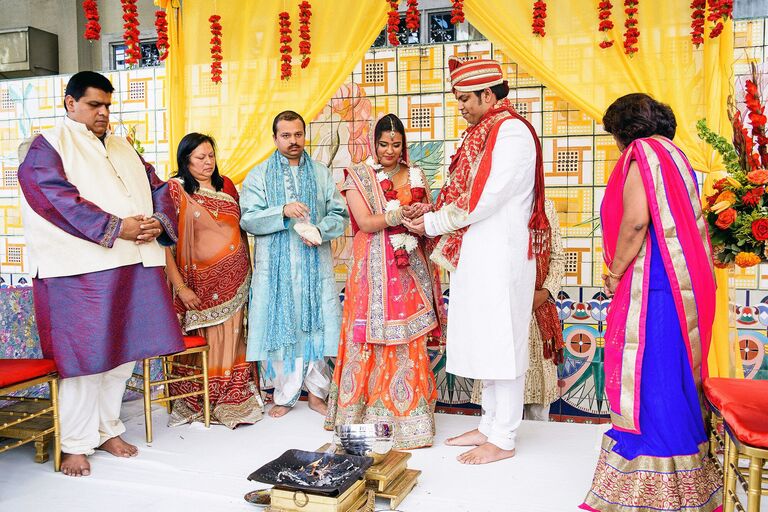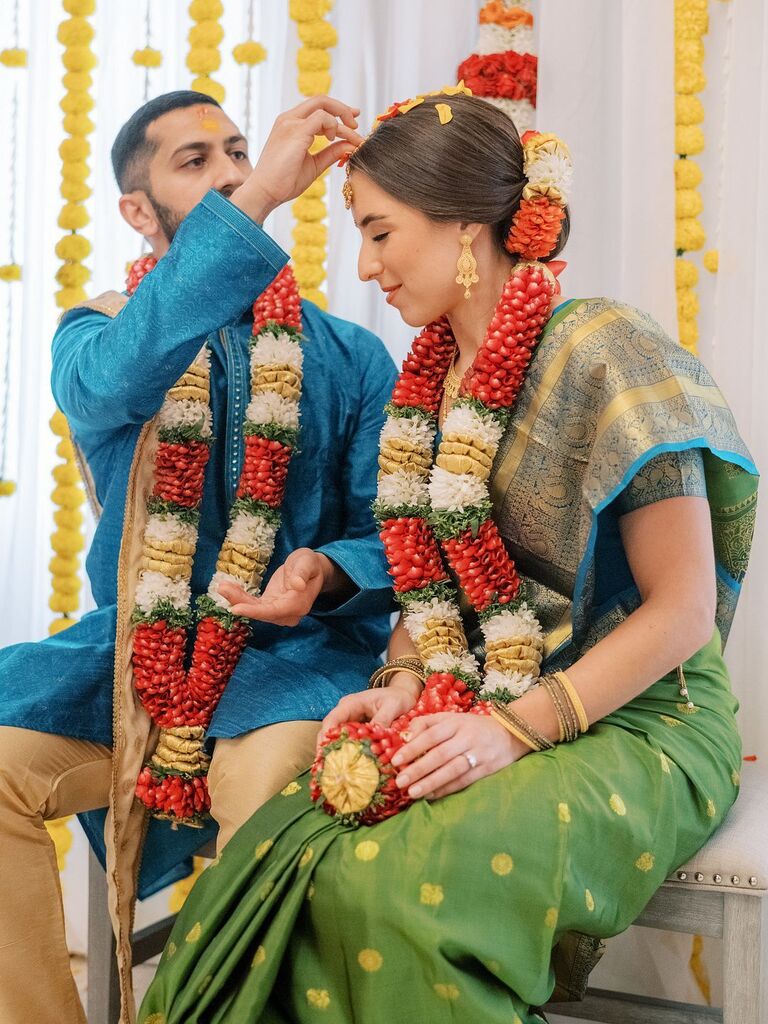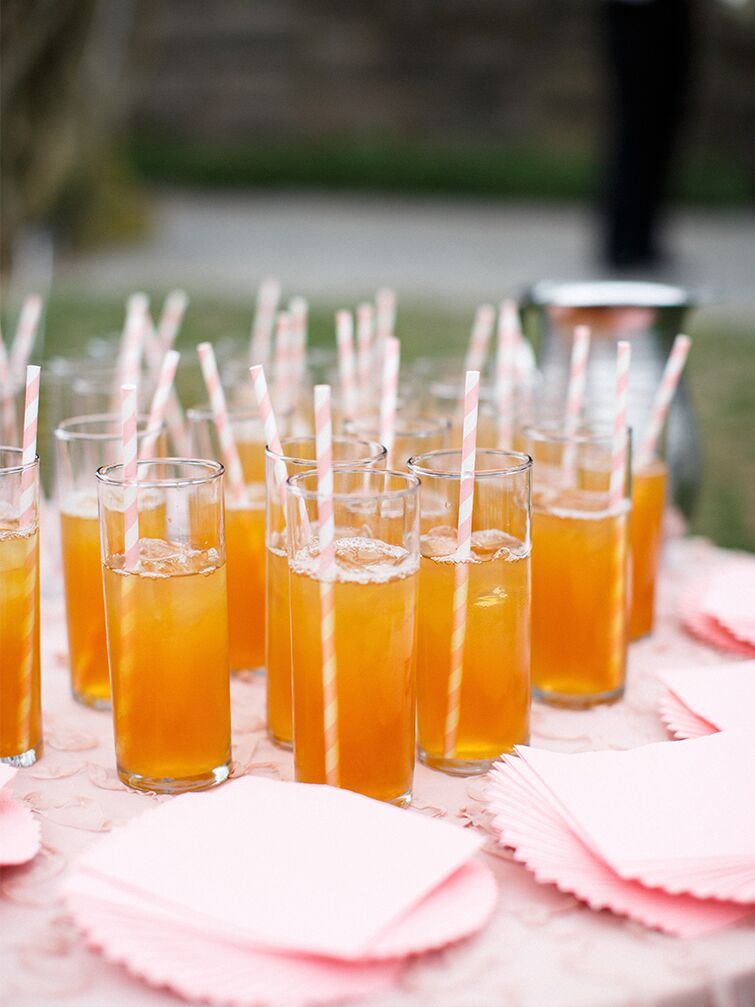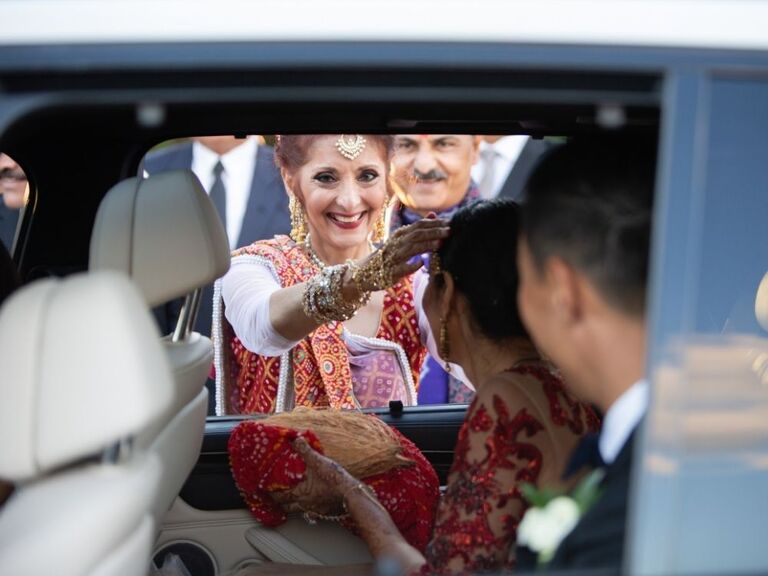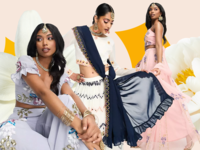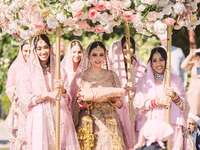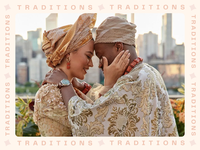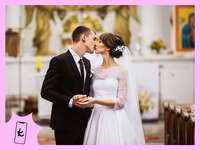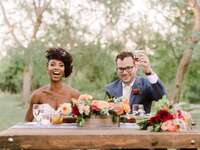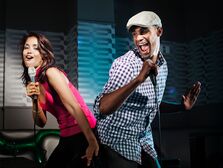37 Hindu Wedding Customs You Might See at a Traditional Celebration
Hindu weddings are steeped in rich traditions and beautiful customs. Whether you're a to-be-wed in the throes of wedding planning, looking for ways to honor your heritage or a wedding guest who doesn't know what to expect at an Indian (Hindu) wedding, you must understand the Indian nuptial traditions included in Hindu weddings. That's why we connected with some of our favorite wedding pros, who are well-versed in Hindu wedding rituals, to get the scoop on all the traditional details. They gave us an in-depth look at what each tradition means and what's involved in each element.
And even though many modern couples are opting to personalize their nuptials, the big day is the perfect time to honor one's culture and religion, even if that means just a few of these ideas get included in your wedding plans. Check out this guide to Hindu wedding rituals, from the engagement to after the reception, and be sure to bookmark it to reference again down the road.
Hindu wedding traditions you should know: History | Prewedding | Attire | Ceremony | Catering | Postwedding
A Brief History of Hindu Wedding Traditions
Hinduism is considered the world's oldest religion, with many of its associated customs dating back to more than 5,000 years ago. It's important to note that the Hindu wedding traditions below aren't in the exact order they're performed since the customs' order depends on what the families want to do and what region of the country they're from. (Fun Fact: India is home to the most Hindus, with more than 90% of Hindus living within its borders.)
Prewedding Hindu Traditions
There are lots of beautiful and fascinating prewedding and engagement traditions around the world, and Hinduism has a myriad of them. Here are spiritual rituals that happen before the big day.
Lagna Patrika

The lagna patrika is the formal engagement ceremony and announcement of the couple's impending marriage. During this time, the couple exchanges a written vow stating that the marriage ceremony will take place at a later date they've selected. The wedding date and time are finalized at the ceremony, which typically has a Hindu priest, also known as a pandit, writing down the marriage details and the names of all the family members involved. This Hindu wedding custom is done months before the special day(s).
Wagdaan
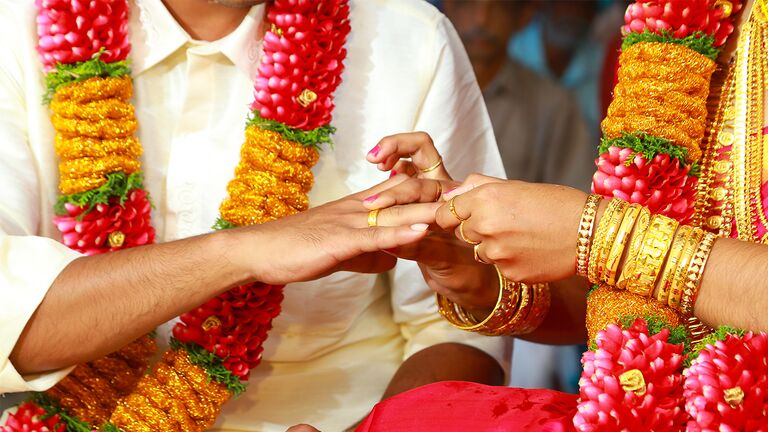
Another Hindu wedding tradition, wagdaan, may also be a part of the engagement. The form wagdaan takes differs from family to family but usually involves the exchange of a ring as a promise of marriage after the groom's father gets permission from the bride's father to have the wedding. The wagdaan typically takes place during an engagement party known as mangni (in northern India) or nischitartham (in southern India). This ritual is the equivalent of a Western-style engagement ceremony.
Roka
The roka ceremony is an extension of the engagement party and celebrates the union of the couple and the families. The two halves join together, exchange gifts, eat sweets and dry fruit and enjoy each other's company.
Barni Band-hwana
Fifteen days before the wedding is the barni band-hwana custom, which involves tying a thread, called mauli, to the bride and the groom or the groom and his parents' hands. The purpose of this is to ask the gods for safety on the wedding day and a happy marriage.
Mayra or Mayara Ceremony
Mayra, also spelled mayara, often follows barni band-hwana and is the "maternal uncle's ceremony" in which the maternal uncles of both to-be-weds shower the families of the to-be-weds with gifts and treats to offer well wishes. Historically, they would also bring the dresses the bride and her mother would wear for the wedding, but that's not always the case with modern weddings in Hinduism.
Sangeet Ceremony
The Hindi word 'sangeet' translates to "sung together" and represents the song- and dance-filled prewedding event where the festivities truly begin. The sangeet ceremony is also referred to as garba in Sanskrit. The goal of the sangeet is to revel in the joy and happiness of the occasion. During the sangeet, loved ones usually perform dances and Hindu wedding songs they've prepared.
Amarjit Keshav, a certified destination wedding specialist of Destination Weddings Travel Group, says this ceremony "signifies the coming together for both families. This event helps to take the stress away from the seriousness of the actual wedding." Gretchen Culver, an event planner with over a decade of experience and Owner and Creative Director of Rocket Science Events, shares that "while Western tradition has a rehearsal dinner, Indian tradition has the sangeet. Historically, the Sangeet was a multi-day affair, but now it's just one day. Sangeets are full of joy. The purpose of a sangeet is twofold. First, to celebrate the couple and second, to connect the families coming together through marriage. It's a great chance for families to get to know each other. There's lots of music, special songs and choreographed dances by family and friends. The guest list for the sangeet is often the same as the wedding, making it a large party in scale and scope."
Mehndi Party
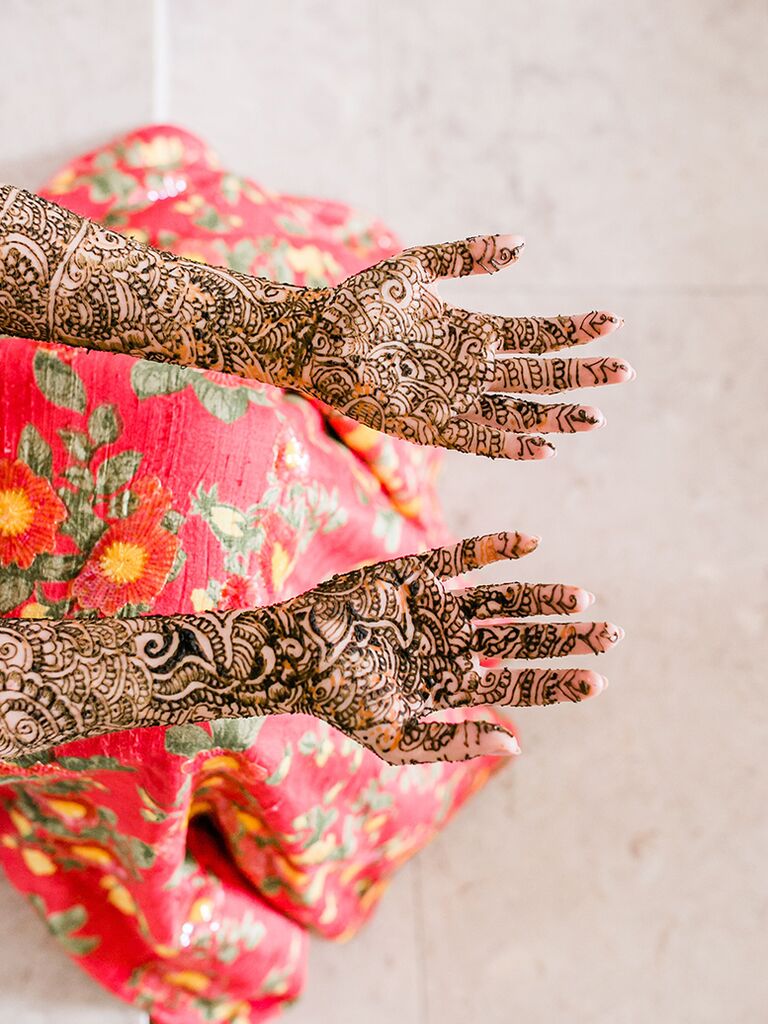
The Mehndi, alternatively spelled mehendi, is one of the most popular Hindu wedding rituals. Traditionally, the bride and many of her loved ones have henna applied to their hands (and sometimes feet) in intricate patterns. The mehndi party is hosted by the bride's parents and the event may include choreographed dances for entertainment since the mehndi application can take a long time. The event often showcases a color palette that's different from what the couple has planned on the wedding day—bright colors, especially oranges and pinks, are popular selections.
"The Mehndi ceremony is hosted by the bride's family and typically takes place a day or two before the wedding," Culver explains. "This tradition is supposed to bring the bride good luck and good health as she begins married life. The mendhi party is akin to a bridal luncheon and a great way for the important women in the bride's life to gather, share advice and memories and bond. Traditional mehndi ceremonies involve only female family members, but male family members are welcome to join after the bride has received her henna. Some grooms are getting henna as well these days."
Henna has properties that help to regulate body temperature. The cooling effect it creates on a bride's hands and feet is said to help relieve stress and headaches. Additionally, according to lore, the darker the henna designs on a to-be-wed's skin, the more loved they will be by their in-laws and new spouse. Plus, they're encouraged to avoid housework for as long as the stain stays on their hands, which can be for up to three weeks.
Tilak Ceremony
The tilak ceremony is another one of the Hindu wedding customs that promote bonding between the two families. During this auspicious welcoming celebration, usually held at the groom's residence, a special mark or "tilak" in Sanskrit is applied to the groom's forehead by the bride's family. This mark, typically made of an ash, clay, sandalwood, turmeric or vermillion paste, represents spiritual devotion and a connection to positive energies. Sometimes rice is sprinkled over the groom, and there's an exchange of gifts.
Haldi Ceremony
The mandvo or pithi prewedding ceremony, also known as the haldi ceremony, involves applying turmeric paste and rose water to the to-be-weds. "Haldi is a Hindi word for the spice of turmeric," Katy Kamali, a passionate event planner and Partner of Bridal Bliss, tells us. "This spice is incredibly healing and is utilized for a prewedding cleansing and purification ritual. The turmeric is made into a paste and rubbed in different areas of the body." The yellow turmeric-based paste is believed to ward off evil, help the couple's skin glow before the big day and bless them with good luck. The haldi ceremony is a fun event that involves both sides of the family, and everyone wears orange and yellow, including the couple.
Traditional Hindu Wedding Attire
It's time to take a quick break from going through Hindu wedding rituals step by step. Instead, let's delve into specific wedding clothing and accessory-based customs seen at Hindu wedding ceremonies.
Red Sari or Lehenga
It's customary for the Hindu bride to wear a red wedding sari or lehenga on her special day. The red hue symbolizes passion, love, prosperity and new beginnings in Hinduism and is even connected to Durga, the powerful warrior goddess. But even though red is a popular color, modern brides can opt for other hues like pastel blue, classic white or bold yellow.
Mangalsutra
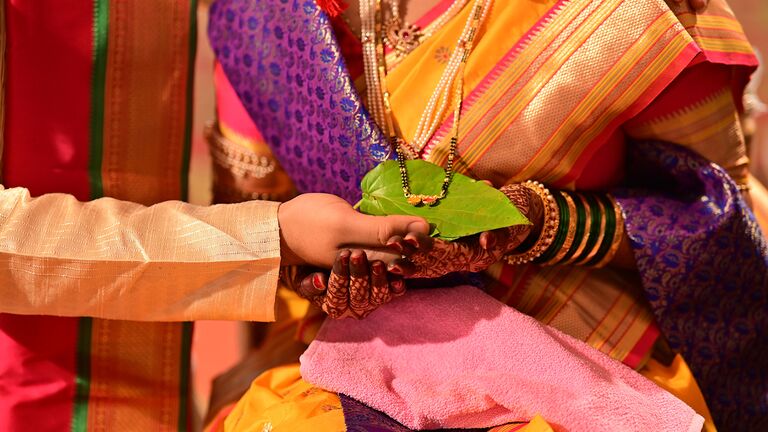
Here's what you need to know about the mangalsutra, which translates to the "auspicious thread." "The mangalsutra is a sacred necklace that's put on the bride [by the groom]; it's worn as a symbol of dignity and signifies the promise for the couple to always be together. It protects against evil and consists of black and gold beads and nowadays can be a fashion statement. It shows people you're married, and it's only to be removed if/when the bride becomes widowed," Keshav says.
Joota Chupai
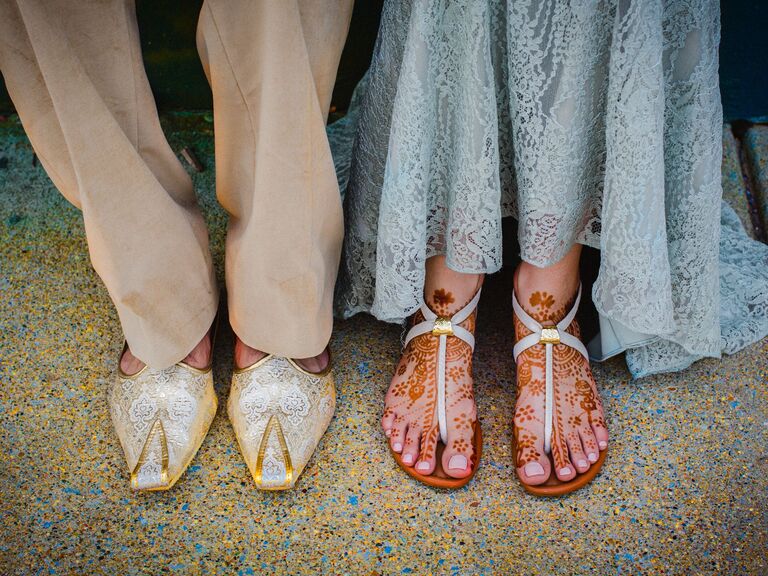
Joota chupai is a playful shoe-related Hindu wedding tradition that Keshav breaks down for us. "When the groom reaches the mandap, he must remove his shoes to enter since everything in the mandap is considered holy. This is the golden opportunity for the bride's sisters, cousins, etc. (all women) to steal the groom's shoes. He won't get his shoes back unless he pays the women money [or gifts] to retrieve them," Keshav states. Fun Fact: Actress Parineeti Chopra, Priyanka Chopra's sister, told reporters that her brother-in-law, Nick Jonas, was expertly prepared for his joota chupai ceremony since he gave all the women money (in dollars and rupees), diamond rings and much more to get his shoes.
Sherwani or Bandhgala
A sherwani or bandhgala is formal attire commonly seen on men at an Indian Hindu wedding ceremony. A sherwani is a long-sleeved knee-length fitted buttoned-down jacket (shown in the picture above) worn usually over a kurta and combined with dress trousers. The bandhgala, also called the jodhpuri, is a suit that originated in the city of Jodhpur in the 19th century. A bandhgala has a closed-collar suit jacket that stops a little below the waist and goes with slim-fitting pants. Both pieces of formalwear can be adorned with gems and intricate embroidery and bring a royal look to any function.
Kurta
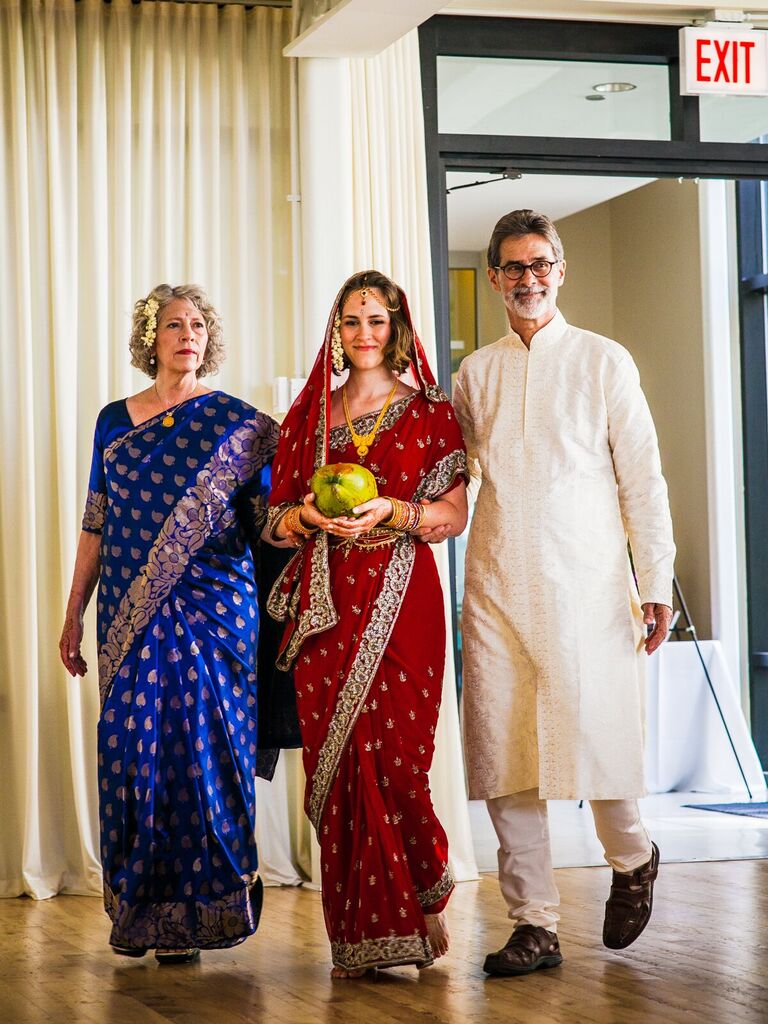
A kurta is a long-sleeved loose-fitting tunic for men that's worn by itself or underneath a sherwani. This collar-less garment is worn with pants for casual or formal affairs and can be made from numerous fabrics like cotton, silk or linen. Feel free to modernize your look by finding one with unique patterns and colors.
Hindu Wedding Ceremony Traditions
There are lots of beautiful Hindu wedding customs done on the wedding day. Here's everything that goes down before the reception, which is typically a big party that doesn't have traditions attached to it.
Baraat
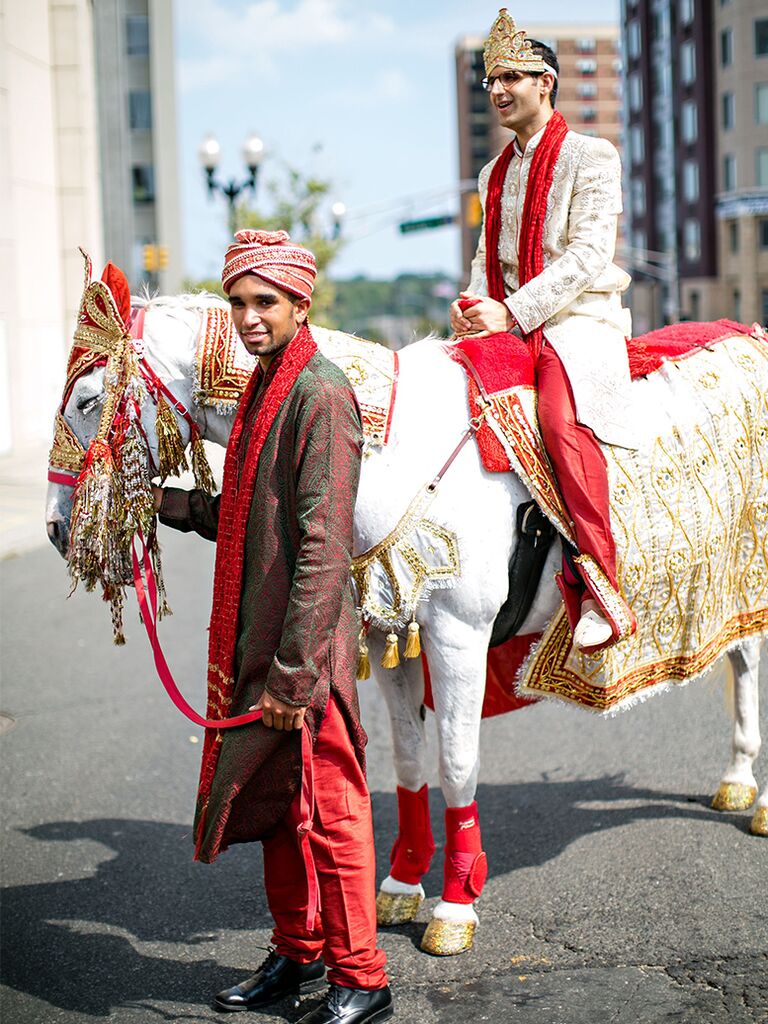
The baraat, sometimes referred to as vara yatra, is a unique wedding ceremony entrance for the groom. There's typically lots of dancing and singing as he enters with a parade of loved ones. "The baraat is a meeting of the families and includes festive music, drummers and dancing," explains Haley. "It begins with the groom's processional to the ceremony. Depending on the area of which the family is from, traditionally, the groom rides in on a horse or elephant and, in modern times, a fancy sports car. Upon arrival, the groom and the group are welcomed by the bride's family, and the couple continues with the wedding ceremony."
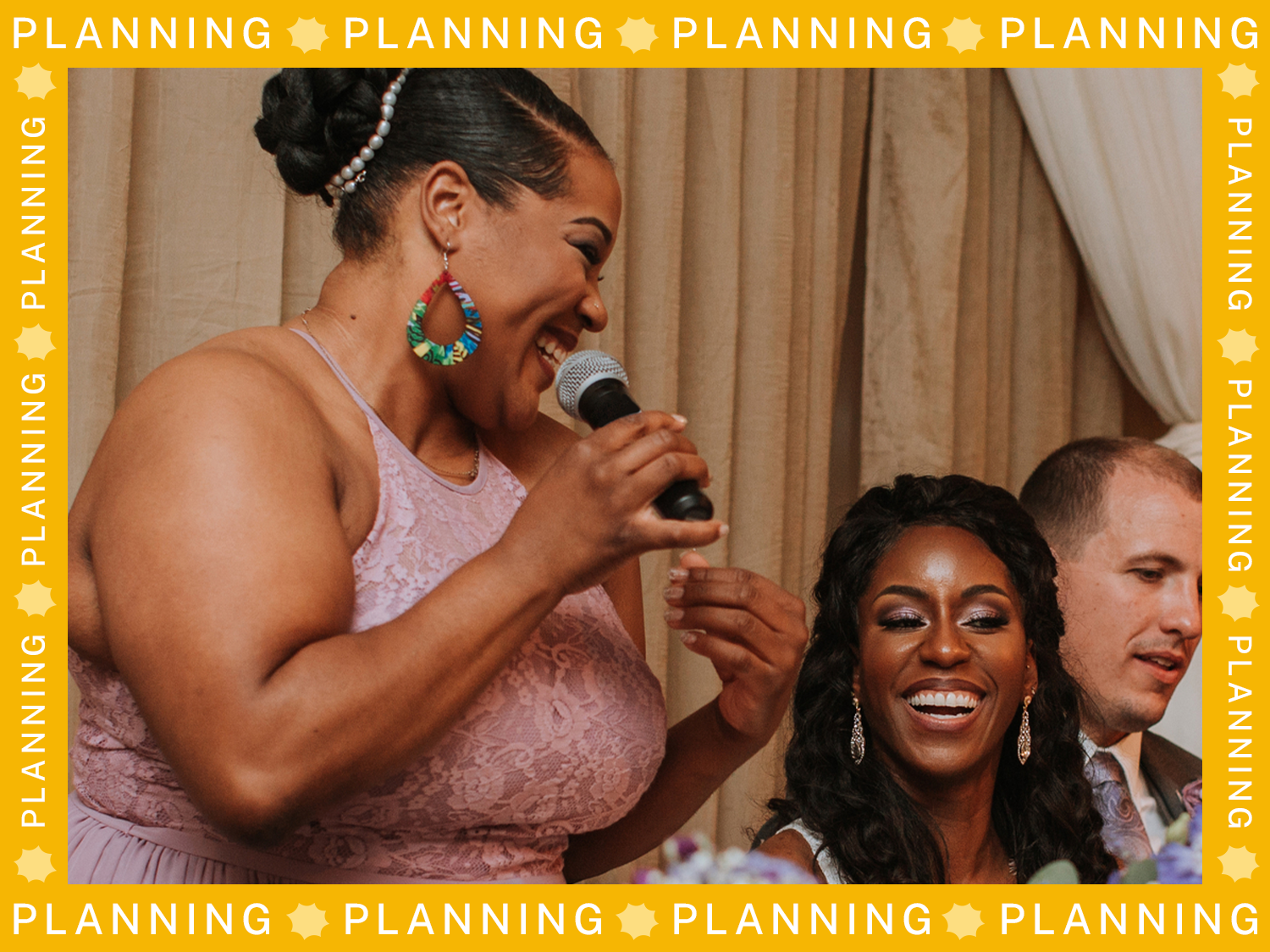
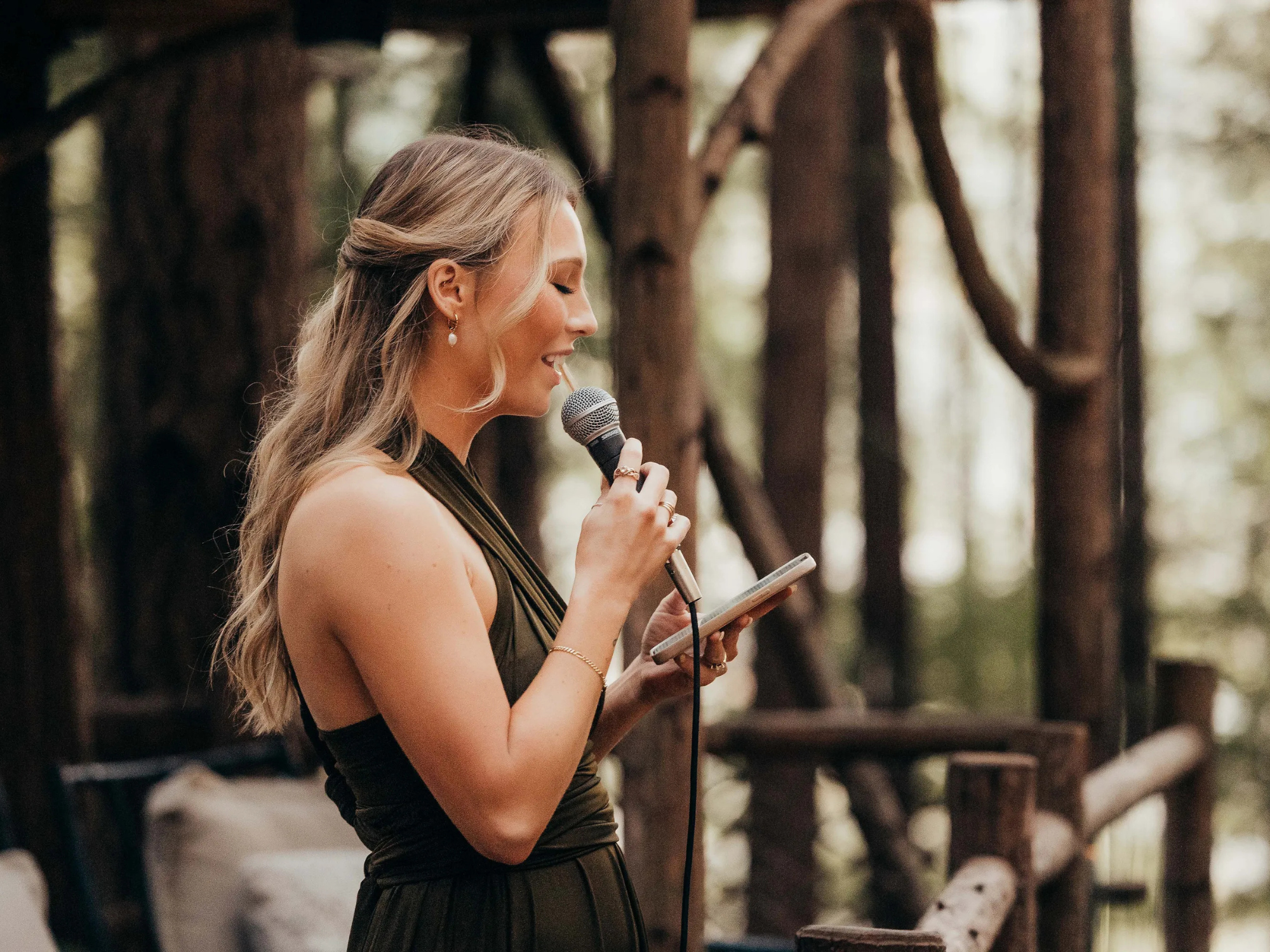
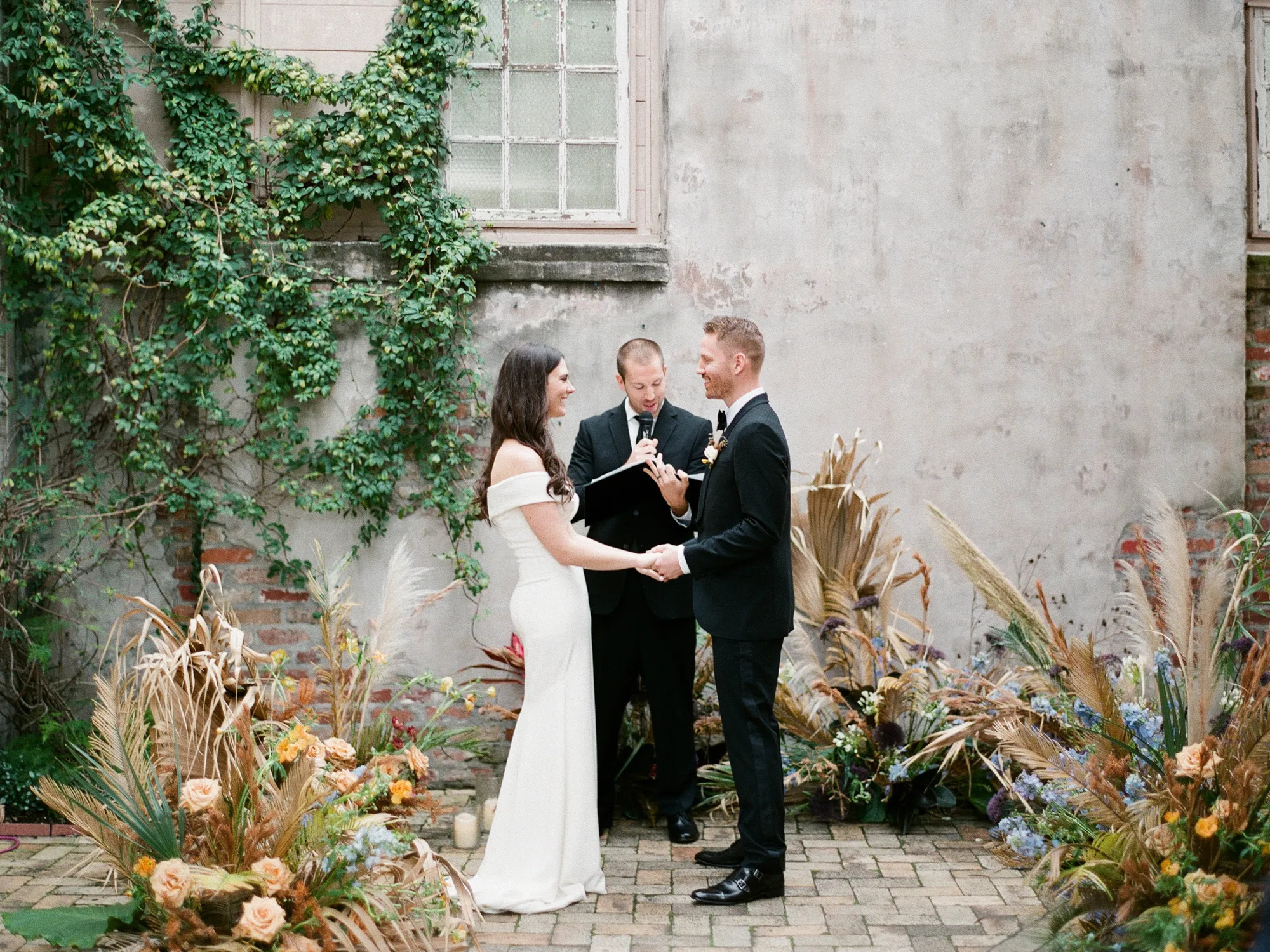
Pokwanu
Pokwanu takes place after the baraat and is another moment when the bride's family welcomes the groom. The bride's mother applies a tilak on the groom's forehead, who's then led inside the Hindu wedding venue for the rest of the ceremonies. The groom is also tasked with smashing a clay pot with his foot into small pieces to symbolize his ability to overcome future obstacles the couple might face.
Ganesh Puja
Some Hindu ceremonies begin with an invocation by a pandit to Lord Ganesh, or Ganesha, the Hindu god of wisdom and salvation. Ganesha is depicted as having an elephant's head. By invoking Lord Ganesh, the Hindu priest removes any obstacles from the wedding ceremony. This is also an opportunity to ask the Lord for peace during the ceremony so it can be performed without hindrances. Items like rice, flowers and fruit are placed on a thali, a round metal tray, as offerings for the deity. (Find the perfect pandit or multicultural officiant for your wedding on The Knot Vendor Marketplace.)
Kanya Aagman
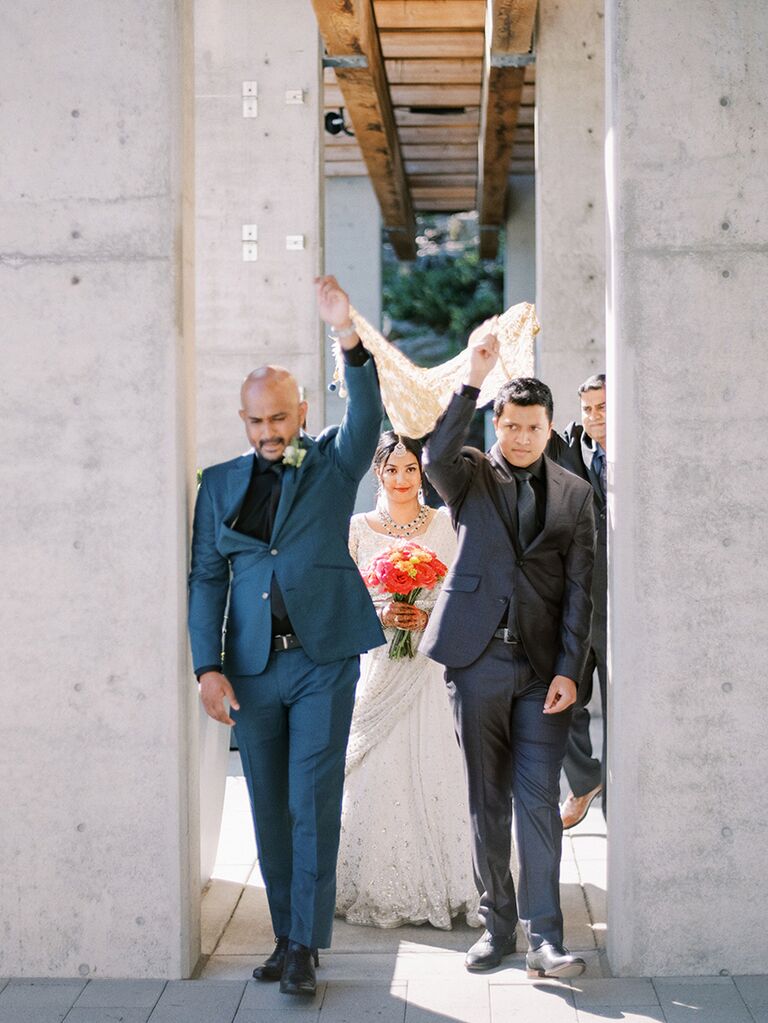
Following the groom's entrance into the wedding and acceptance with tilak, the bride enters next during kanya aagman. Kanya aagman is the Hindi phrase for "the girl's arrival" or "the arrival of the bride." During the bridal processional, the to-be-wed will often walk underneath a phoolon ki chaadar, a sheet usually adorned with flowers that represent the bride leaving the protection of her family to be with her groom, held by her brothers. Loved ones, often the bride's maternal aunt and uncle, will generally join the procession. The soon-to-be bride is then led to the mandap, where the groom, his loved ones and the pandit are seated.
Mandap
Kanya aagman ends with the bride's arrival at the mandap, which is the location where the wedding ceremony takes place. Jaime Kostechko, who has 16 years of planning experience and is the Owner and Creative Director of Wild Heart Events, notes that "while the mandap serves as the structural altar for Hindu weddings, it also signifies a fruitful married life. There are many interpretations as to the representation of the four pillars of the structure, such as representing the parents of the couple, the four stages of life (Brahmacharya, Gṛhastha, Vanaprastha and Sannyasa) or the four important aspects of human life (Dharma, Artha, Kama and Moksha) but regardless of what you believe, the structure itself has become the focal point of the wedding. Even with modern interpretations of Indian wedding designs, more is more when it comes to the mandap."
Keshav elaborates, sharing that "this is the ceremony structure that's used for the sacrament of Hindu marriage. Just like a chuppah, it has four sides and is covered. Hindus use a small haven with a fire, which wards off all evil. The ceremony begins with the priest chanting the prayers, and the wedding couple will circle the fire seven times. The four sides of the mandap represent the earthly elements and the parents from both sides, which are seen as the pillars of the new foundation forming in the marriage."
Varmala
During varmala, alternatively known as milni mala or jai mala, the couple exchanges floral garlands. The garland is typically made up of brightly colored jasmine flowers, roses or marigolds. The garland exchange symbolizes the couple accepting one another into their families. Those who want to make this Hindu wedding ritual playful, they compete to see who can put the garland on the other person first.
Kanyadaan and Hasta Milap
Kanyadaan means "giving away the bride" in Sanskrit and is a symbolic ritual during Hindu wedding ceremonies. First, the bride's family will take the bride's right hand and place it in the groom's right hand. Then, sacred water is poured over the couple's joined hands. This symbolizes the request for the couple to enter into marriage as equal partners and mix as husband and wife. The hasta milap takes place next and involves the bride's parents tying the couple's right hands together with a cloth to present an unbreakable bond between the newly married duo.
Granthibandan
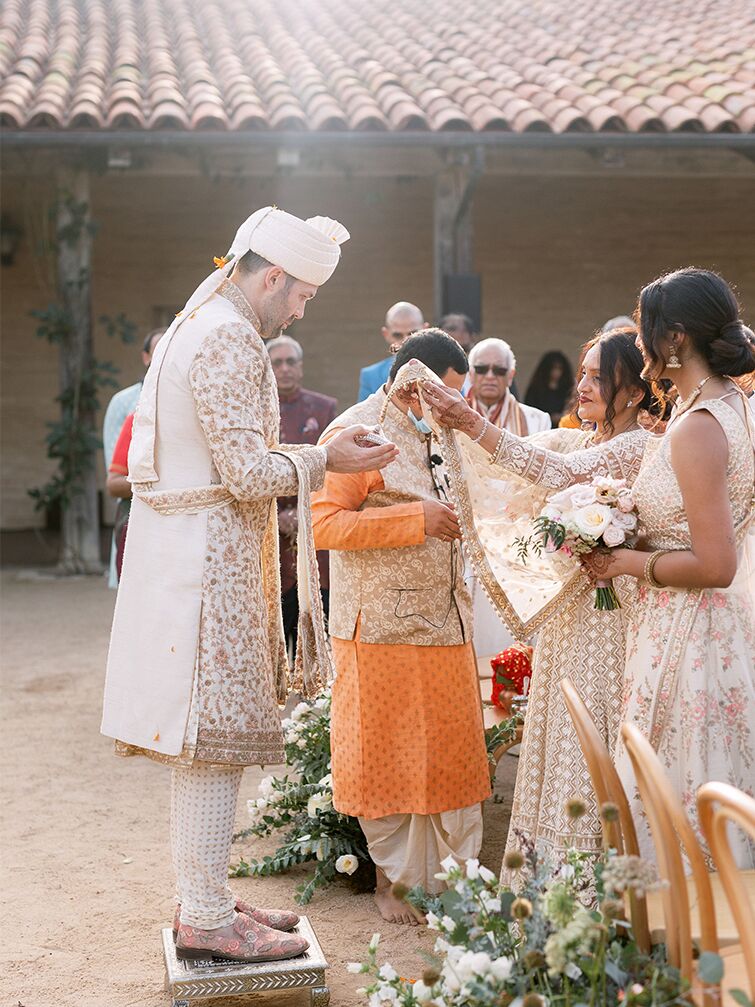
The granthibandan part of a Hindu wedding ceremony is when the couple "ties the knot." During this ritual, the groom's scarf is tied to the bride's pallu or saree, while they chant prayers to deities asking for a strong and healthy marriage. Tying the two garments together represents the couple's souls joining together in new life through holy matrimony.
Saptapadi
Keshav explains that during this Hindu wedding custom, the couple will take "seven steps around the holy fire, otherwise known as saath phera or saptapadi, are the Hindu wedding vows that the couple takes while circling the sacred fire. Each vow and step signify a stage in the marriage that the couple will encounter. These vows are part of the Hindu/Vedic rituals and are taken very seriously. These vows sanctify the union between the two souls." Haley goes on to note these wedding blessings in "the seven steps around the holy fire are the most significant portion of a Hindu wedding ceremony. The steps are taken together, and each step represents seven different prayers: food, strength, prosperity, family, offspring, health and friendship. Once the final step is taken together the couple is considered married."
Sindoor
The groom applies sindoor, a red or orange-red colored powder, to the middle part of the bride's head––this ritual shows the bride is married. At some weddings, sindoor is put across the entire hairline or simply as a dot on the forehead based on where the families are from and what the bride wants.
Aashirwad
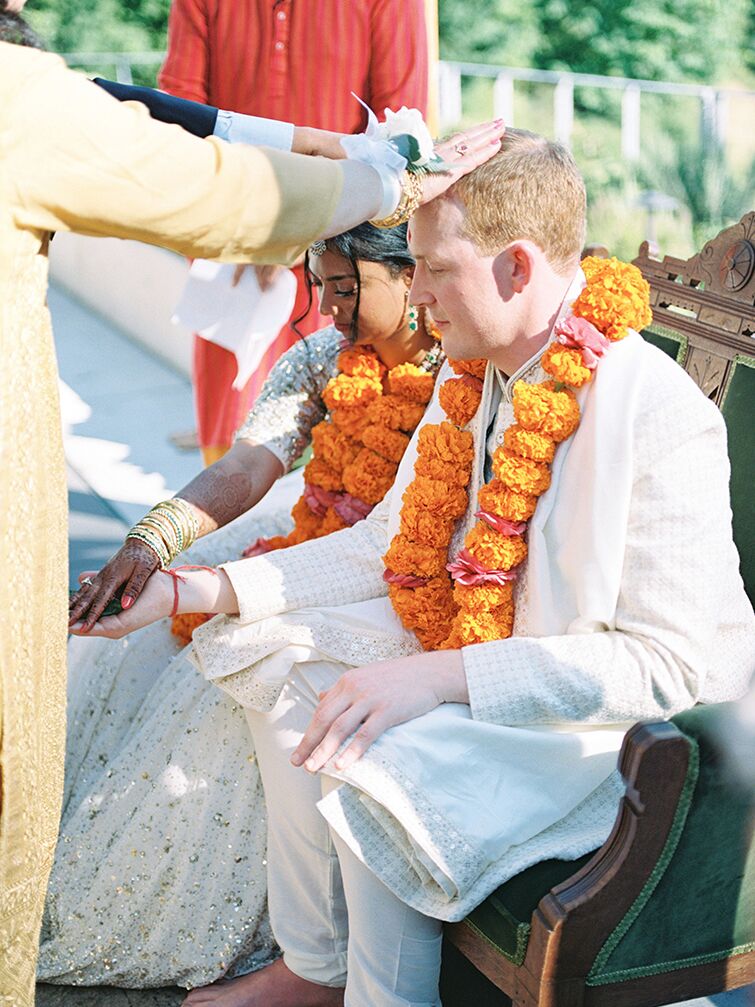
On many Hindu wedding programs, you'll see aashirwad, which is when the couple receives a blessing from their families at the end of the ceremony. This is part of the grand finale of the ceremony. Upon being blessed by their families, the couple will recess away from the wedding ceremony as guests shower them in flower petals.
Traditional Hindu Wedding Food, Drinks and Desserts
The foods below aren't specific to Hindu celebrations, but you'll most likely see them on the menu. Talk with your caterer and incorporate one or more of these wedding food traditions.
Samosas
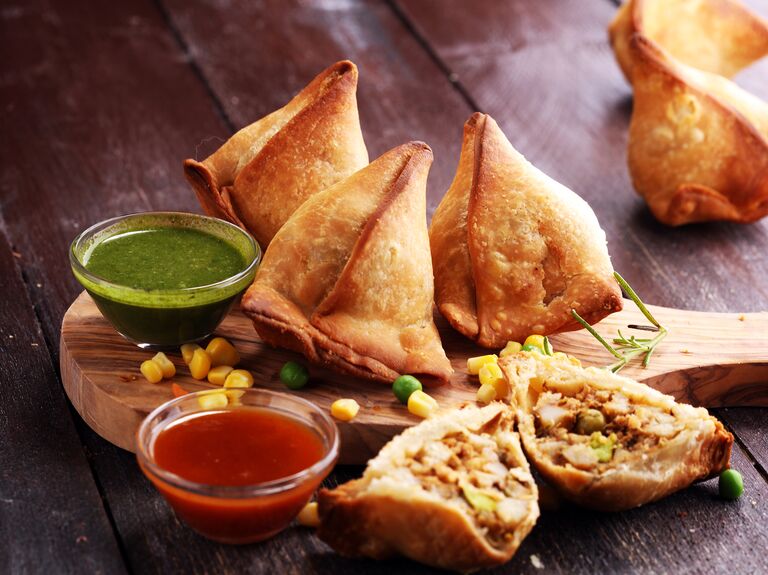
Considered by some to be India's most popular appetizer and snack, samosas are triangular pastry delights that are full of flavor. The fried or baked bites are stuffed with spiced meat or vegetables and can be served with a variety of tasty chutneys (a condiment or spread) if you would like to have a samosa station at your Hindu wedding reception.
Biryani
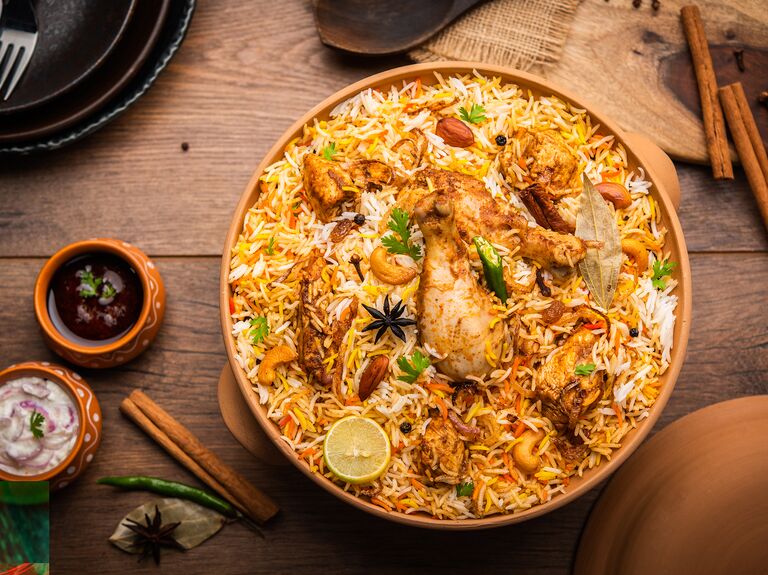
For the main course, biryani is king at the dinner table. This fragrant rice-based dish can be vegetarian or with meat and is packed with delicious spices. This staple has lots of variations depending on which region is taking over the kitchen, so have fun having different options at your celebration. Plus, it's super easy to make large quantities of biryani to help fill up your guests.
Chaas
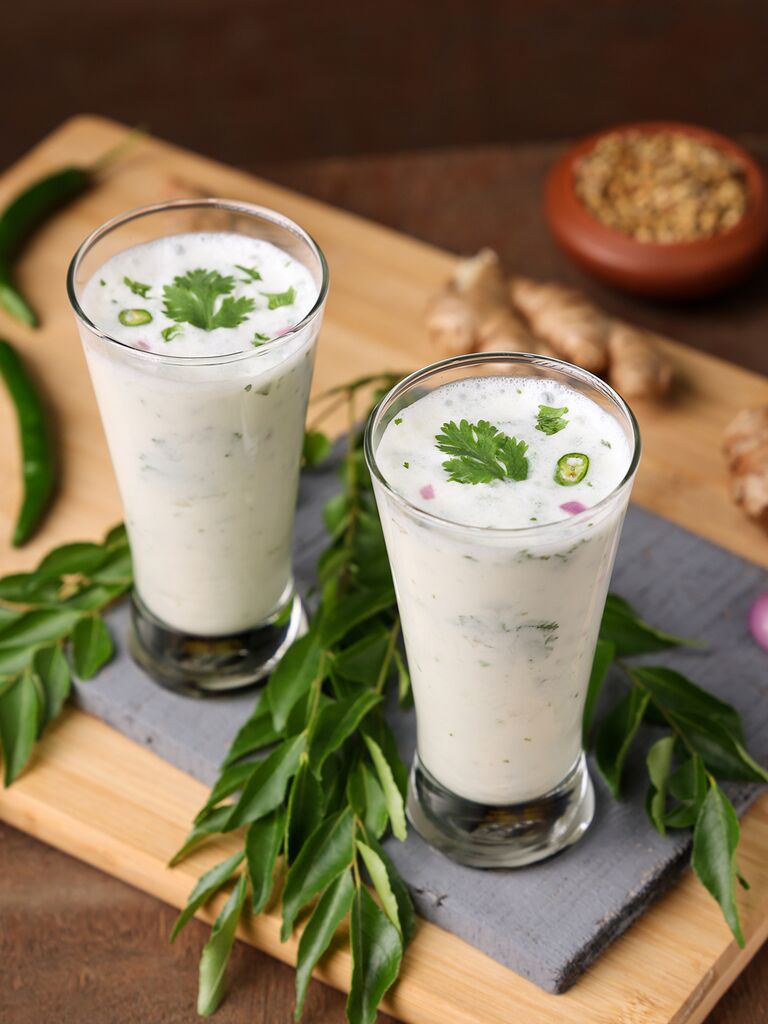
Chaas, also called mattha, is a spiced Indian buttermilk drink that's a refreshing option after a spicy meal. Traditionally, chaas is made from curd, yogurt or cultured cream and is mixed with water, spices and herbs to help with digestion and cooling. If you're having an outdoor summer wedding, this drink is perfect for your ceremony, cocktail hour or reception.
Fresh Fruit Juice
On a warm day, give your guests prewedding ceremony drinks––a new nuptial drink trend. Fresh mango juice is the most popular option in the summer. Consider adding ripe slices of mangos to each glass for a special touch.
Gulab Jamun
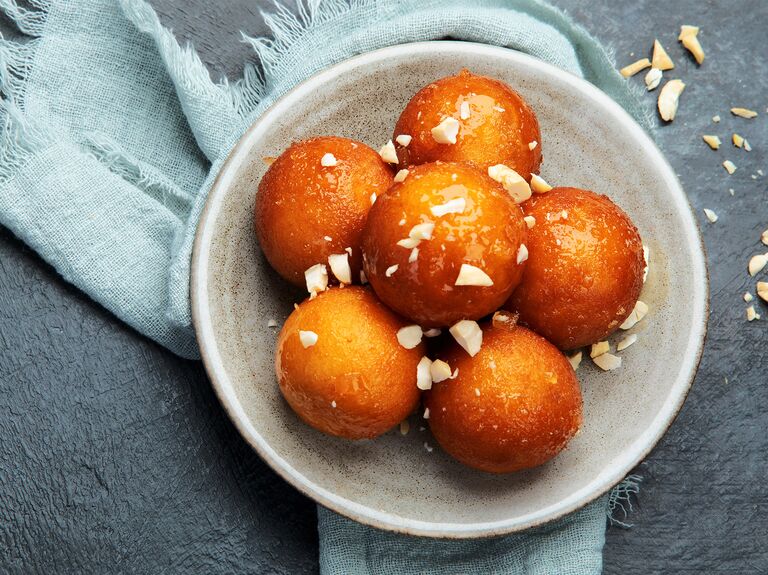
Just about every Indian wedding will have gulab jamun at their dessert table. These small fried dough balls are soaked in a cardamom and rose water sweet syrup. Ask your dessert vendor what modern takes they can make on this famous dish to make your wedding more unique.
Kulfi
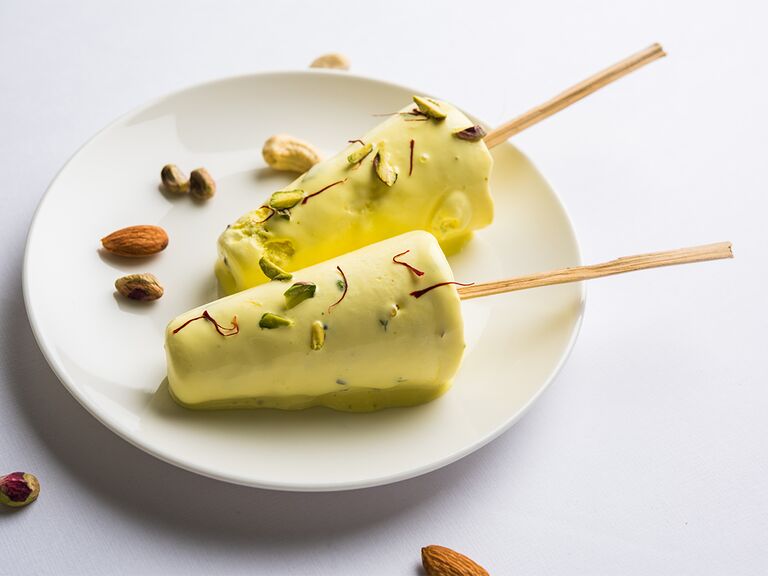
Kulfi is like your classic Western-style ice cream but with more density. Kulfi can be made using a variety of flavors, so we suggest having an ice cream cart at your reception with popular delights like saffron, mango, pistachio and chocolate.
Hindu Postwedding Traditions
Even after the wedding, there are Hindu rituals that must be completed. Here are six things that happen after the reception.
Vidaai
Vidaai, also written as bidaai, is said to be one of the most emotional Hindu wedding-related customs. When this grand farewell takes place depends on the family's preferences and origin, but the steps remain very similar. While exiting, the bride throws a mixture of rice, flower petals and coins behind her to her parents five times without looking. This ritual represents the daughter's gratitude for her family and is a way of paying them back for their kindness over the years. The items thrown are symbols of wealth and prosperity.
Aashirvaad
The aashirvaad ceremony, typically a few days after the wedding, is when the bride's family and loved ones go to the groom's home to offer the newlyweds treats and gifts. This act is another way of showing their approval of the couple's union. Also, the bride's front entrance at her home is decorated with mango leaves to symbolize fertility and welcome the gods––these must stay there for one year.
Dwar Rokai
Another fun Hindu wedding custom is dwar rokai. Once the new couple arrives at the groom's house, the groom's sister is tasked with blocking their entry into the home. The groom must then bribe his sister with cash or gifts so they can enter the house.
Griha Pravesh
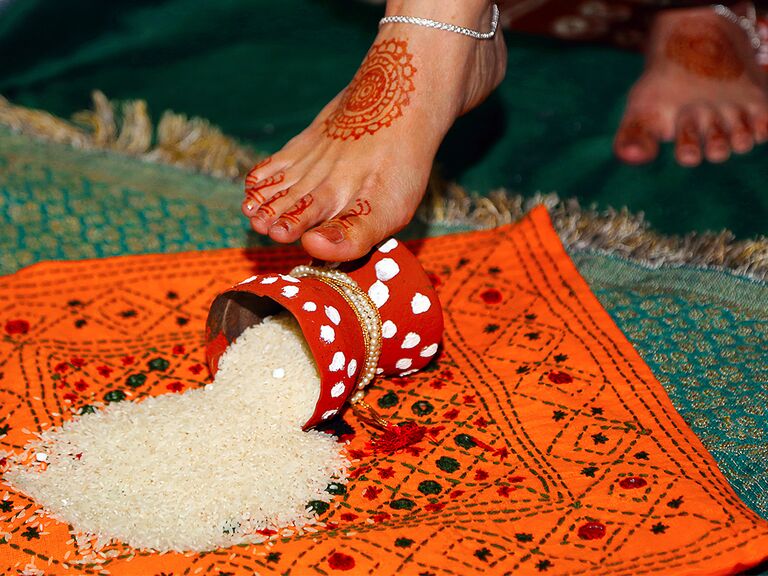
After the dwar rokai tradition, the griha pravesh ceremony happens before entering the house and shows that the bride is welcomed by the groom's family. The groom's mother adds tilak to the newlyweds, who then ask to be blessed by the elders there. At the door's threshold is a Kalash (or pot) of rice that the bride must push over with her right foot to symbolize prosperity. Sometimes, the bride must then, barefoot, step into a dish of vermillion powder or Alta, so when she walks into the home she leaves auspicious red footprints behind. The footsteps represent the arrival of Goddess Lakshmi who is the symbol of wealth, happiness and good fortune. Plus, in some regions, the bride must say the groom's name to enter the home.
Mooh Dikhai
The welcoming ceremonies and gifts continue with mooh dikhai, the "face revealing" tradition. Mooh dikhai usually happens at home on the night of the wedding and is when the women of the family unveil the bride's face and offer her treats and presents. The mother-in-law is a large part of this and helps the bride "reveal" her face to her new family.
Pag Phera
For this final Hindu wedding ceremony, the bride returns to her family home and stays there for about three days. Some think that since women are extensions of Goddess Lakshmi, they must come home temporarily after the wedding to bring prosperity to their parents. Once the period is over, the groom takes the bride back to his home, but not before getting blessings from his in-laws, and the couple receives presents from the bride's family.
Hannah Nowack contributed to the reporting of this piece.
